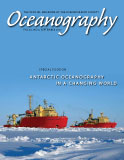Article Abstract
The West Antarctic Peninsula (WAP) shelf is deep and detritus-based (i.e., it is fueled by organic material sinking from intense seasonal cycles of primary production in the water column), leading to pelagic-benthic coupling. The WAP is warming rapidly, yielding increases in seawater temperatures and reductions in sea ice that may fundamentally alter pelagic-benthic coupling and shelf benthic ecosystems. RVIB Nathaniel B. Palmer and ARSV Laurence M. Gould have provided year-round access to the WAP sea ice zone, facilitating studies of pelagic-benthic coupling and climate change. In the Food for Benthos along the Antarctic Continental Shelf (FOODBANCS) Project, we conducted a 15-month field program to evaluate benthic ecosystem function across the mid-WAP shelf, testing the hypothesis that “phytodetrital material deposited from the summer bloom provides a sustained source of food for benthic detritivores during winter months, when organic-matter flux from the water column is extremely low.” We found that the intense seasonality in primary production and food availability in the WAP water column is heavily dampened at the shelf floor by the presence of a “food bank” that sustains benthic ecosystem functions (including sediment-community respiration, deposit feeding, vitellogenesis, spawning, and recruitment of benthos) over the winter; this food bank also influences community structure and life-history strategies of the WAP benthos. The persistence of the food bank may be mediated by low bottom-water temperatures, with the consequence that climate warming might reduce food availability in shelf communities. During the FOODBANCS2 Project, we studied the benthic ecosystem response to the strong latitudinal sea ice gradient along the WAP to explore the ecosystem consequences of sea ice loss from climate change. We found that some aspects of benthic ecosystem structure (e.g., macrofaunal dominance by the polychaete Aurospio foodbancsia) covaried with sea ice duration and are likely to be sensitive to sea ice loss. Other benthic parameters (e.g., the standing crop of macro- and megabenthos) exhibited nonlinear responses, with evidence of resilience along much of the sea ice gradient and abrupt change near one end. Still other benthic parameters (e.g., sediment community respiration) changed very little with sea ice duration. We also found that climate warming is facilitating invasion of the WAP shelf by predacious king crabs, with dramatic reduction in benthic biodiversity and altered ecosystem function. In summary, some important benthic ecosystem parameters along the WAP may be resilient to climate-induced changes in pelagic-benthic coupling, while many others may be highly sensitive, responding nonlinearly to sea ice loss. Incorporation of climate change effects into WAP benthic ecosystem models, including the effects of invasive species, will be challenging until mechanisms, nonlinearities, synergies, and tipping points of climate change effects are better understood.

